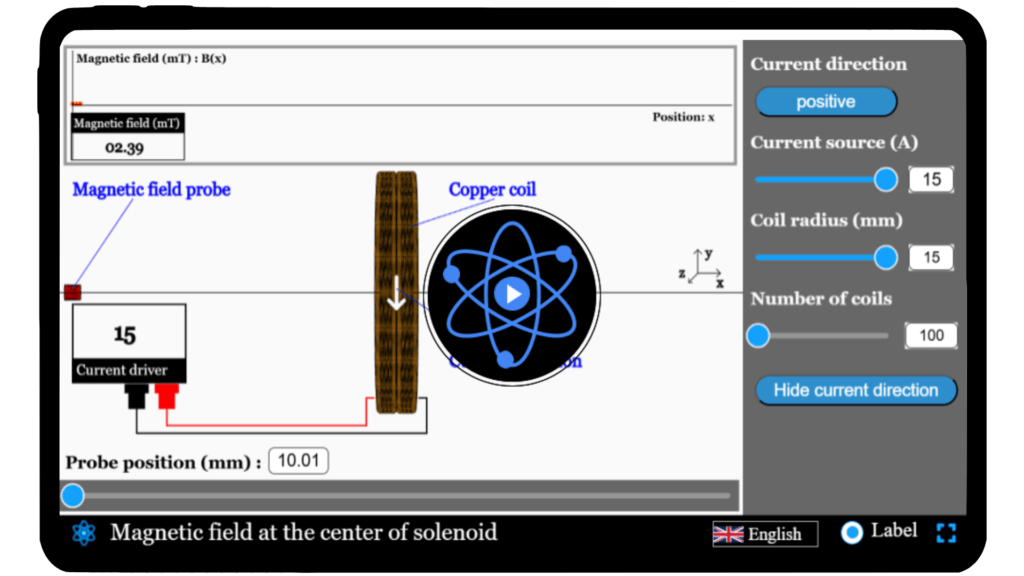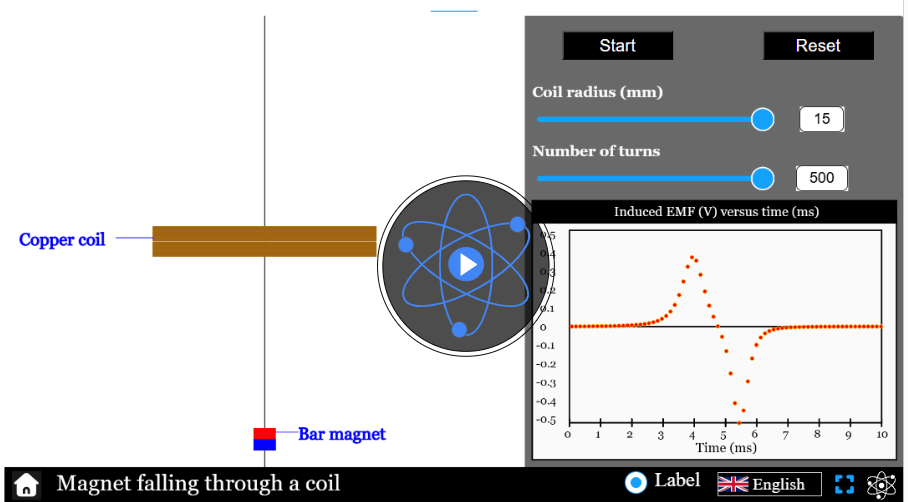Solenoid simulator
Visualize and experiment with the magnetic field at the center of a pair of coils in a Anti-Helmholtz configuration using our interactive simulator.
Solenoid
Solenoids play a crucial role in electrical circuits, powering everything from door locks to automotive starters. Our advanced solenoid simulator brings the physics behind these essential components to life. Explore and experiment with the electromagnetic principles that make solenoids indispensable in modern technology. Adjust the controls, change variables, and observe the changes in magnetic fields in real-time. Clarify your doubts, deepen your understanding, and experience the magic of solenoids firsthand. Dive in and start simulating now!
\( B = \mu_{0}nI
\)
Mathematical description
where:
- \( B \) is the magnetic field at the center of solenoid
- \( \mu_{0}\) is the permeability of the free space
- \( n \) is the number of turns per length
- \( I\) is the current flowing through the coil
FAQs on Solenoid
Qus 1. What is a solenoid and how does it work?
A solenoid is a coil of wire that generates a magnetic field when an electric current passes through it. This magnetic field can be used to convert electrical energy into mechanical motion, making solenoids essential in applications like electromagnets and relays.
Qus 2. How does a solenoid generate magnetic field?
A solenoid is a long, tightly wound coil of wire shaped like a cylinder. When electric current flows through it, a magnetic field is created around each turn of the coil. According to Ampère’s Law, the magnetic field strength is proportional to the current and the number of turns in the coil.
Using the right-hand rule, if you curl your fingers in the direction of the current, your thumb points in the direction of the magnetic field inside the solenoid. Inside a long solenoid, the magnetic field lines are nearly parallel and evenly spaced, creating a uniform magnetic field that is strongest in the center and decreases near the ends.
Qus 3. How is the magnetic field inside a solenoid calculated?
The magnetic field inside a solenoid can be calculated using the formula \(B=\mu_{0}nI\), where \(\mu_{0}\) is the permeability of free space, is the number of turns per unit length, and is the current flowing through the coil. This formula helps in designing solenoids for specific applications.
Qus 4. How can I increase the magnetic field strength of a solenoid?
To increase the magnetic field strength of a solenoid, you can increase the number of turns of the coil, increase the current passing through the coil, or use a core material with higher magnetic permeability. These adjustments enhance the solenoid’s magnetic performance.
Qus 5. What are the advantages of using solenoids in electrical circuits?
Solenoids offer several advantages, including precise control of mechanical movement, fast response time, and high reliability. These features make them ideal for applications requiring quick and accurate actuation.
- Precise control of mechanical movement: Solenoids are widely used in various applications, including automotive starters, door locking mechanisms, valve actuators, and electromagnetic switches. Their ability to precisely control mechanical movement makes them invaluable in many industries.
- Fast response time: Solenoids can quickly switch states, providing fast response times essential for applications like relays, switches, and actuators.
- High Reliability: Solenoids are robust and durable, offering reliable performance over long periods, even in demanding environments.
Qus 6. How solenoids are able to precisely control mechanical movement?
Solenoids often include a movable component that responds to the electromagnetic force generated when current flows through the solenoid’s coil. This component, called a plunger, is essentially a cylindrical rod made of ferromagnetic material (such as iron or steel) positioned inside or near the solenoid coil. When the solenoid is energized, the magnetic field created by the coil exerts a force on the plunger, causing it to move linearly (in and out of the coil). Plungers are commonly used for linear actuation (movement) in applications such as door locks, automotive starters, and pneumatic or hydraulic valves.
Qus 7. What are the common applications of solenoids?
Solenoids are widely used in various applications, including automotive starters, door locking mechanisms, valve actuators, and electromagnetic switches. Their ability to precisely control mechanical movement makes them invaluable in many industries.
- Non-Contact Operation: Solenoids can actuate devices without direct physical contact, reducing wear and tear on mechanical parts and extending the lifespan of the system.
- Fluid Regulation: Solenoids precisely control the opening and closing of valves in fluid systems, ensuring accurate flow regulation in applications like fuel injection systems and industrial process control.
- Security Systems: In electronic door locks, solenoids provide precise actuation to engage and disengage locking mechanisms, ensuring secure and reliable operation.
- Automation: In robotics, solenoids are used to control precise movements of robotic arms and grippers, enabling accurate positioning and manipulation of objects.
Qus 8. Can solenoids be used for both AC and DC applications?
Yes, solenoids can be designed for both AC and DC applications. However, DC solenoids typically provide more consistent performance and are preferred for applications requiring precise control, while AC solenoids are often used in high-power applications.
Qus 9. What is the difference between a solenoid and an electromagnet?
A solenoid is a specific type of electromagnet designed to produce linear motion when energized. While all solenoids are electromagnets, not all electromagnets are solenoids. Electromagnets can have various shapes and configurations for different applications.




